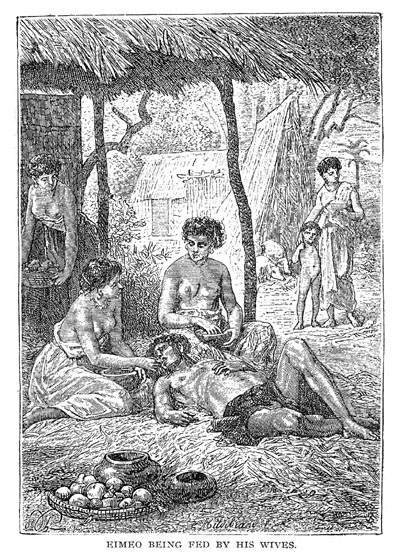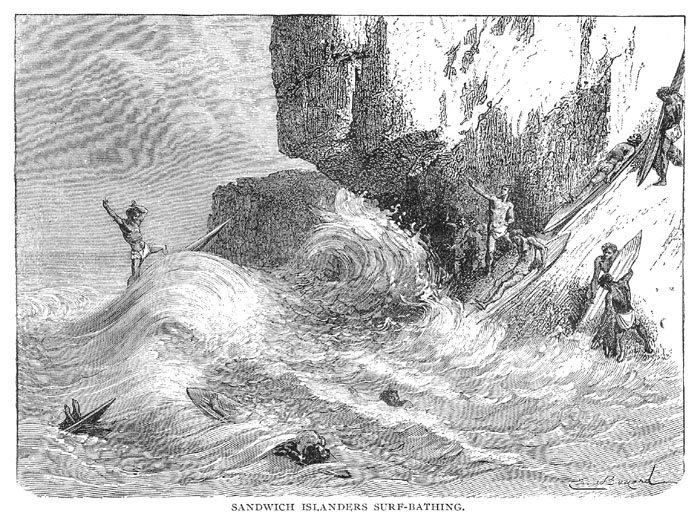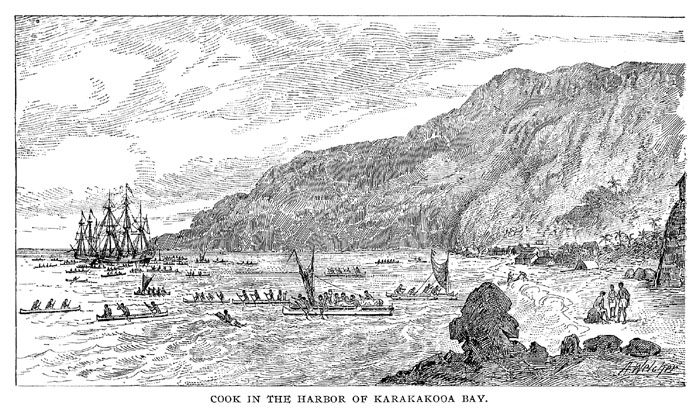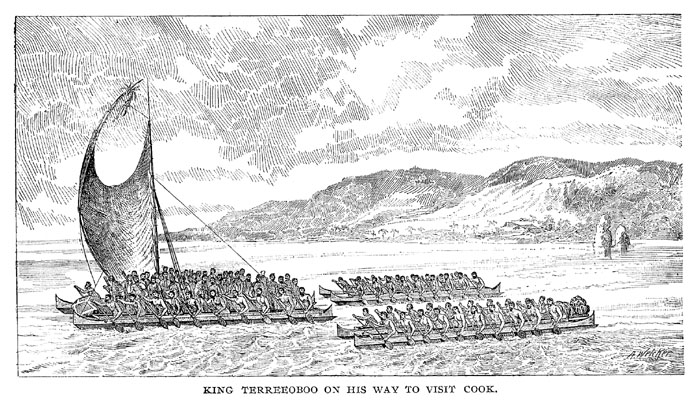A DANCE OF THE KING'S FOUR SISTERS.
 |
A few days after, a battle occurred between the navies of Otaheite and Eimeo, in which the latter were defeated, though only three men were killed, whose bodies were sacrificed to Eotua, after the same manner as just before described. Cook then visited Eimeo, peace having been concluded, and after a short stay on that island, went to Huaheine, where he built a house and set up Omai in the most comfortable manner and with agreeable surroundings. One of the peculiar habits observed by Cook to characterize Eimeo was the indulgences of such indolence that his wives actually fed him as he lay prone upon the ground in apparent helplessness like an infant; but upon enquiry it was ascertained that Eimeo considered it below the dignity of royalty to administer to any corporal need which a servant or wife might relieve.
Cook took his departure from the Society Islands December 19th, and on the 24th discovered Christmas Island, where a stay of a week was made and spent in fishing, catching turtles and observing a partial eclipse of the sun.
DISCOVERY OF THE SANDWICH ISLANDS.
On January 2d, Cook weighed anchor, and proceeding northward, on the 18th he discovered a considerable body of land, and upon nearing shore he was visited by several canoes laden with men. They approached without signs of fear, and to Cook's surprise and pleasure, he found that their language was the same as that spoken by the Otaheitans. He soon discovered that the island which he had thus happened upon was one of a considerable group, which, in honor of his patron, the Earl of Sandwich, he named the Sandwich Islands.
Making a considerable stay at these islands, Cook was enabled to familiarize himself with the habits and peculiarities of the natives, who appeared at all times peaceably disposed. In many respects, he found them to
 |
The people lived in more comfortable and pretentious huts than any other islanders whom Cook had met with, and though hardly more delicate in their manners, took greater pains to conceal their nakedness; nor did they mutilate their ears and noses as do most of the Pacific islanders. Like the people of Otaheite, the Sandwich natives make cloth from the bark of a tree, but possess an art of coloring it much more perfectly and pleasing than those of other islands. Their weapons were spears, knives of hard wood, bows and arrows, slings, and hatchets of stone. But a few pieces of hoop iron were found among them, which they must have purchased from other islanders or taken from the wrecks of ships blown to their shores, as Cook was certainly the first white man to visit them. Their canoes, often thirty feet in length, were both double and single, and the larger were provided with latteen or triangular sails, stretched on a long yard; but their propulsion was principally by paddles.
 |
A VISIT TO THE PEOPLE OF NOOTKA SOUND.
On the 6th of March, he discovered the shore of North America, then known as New Albion, along which he coasted, in a stress of bad weather, with slow progress until the 29th, when he came in sight of the territory of British America. Here he came to anchor in a cove which he called Hope Bay, in the vicinity of Vancouver Island, and directly after saw a dozen natives on the shore, one of whom, probably a chief, began to harangue the white visitors in a very loud voice, at the same time shaking a rattle and strewing feathers towards them. Finding their invitations to land treated with indifference, the natives soon multiplied, and from the shore shot out thirty-two canoes which directly surrounded the ships.
The next morning, Cook moved his ship into a more favorable harbor, which he called Nootka Sound, and then went on shore to visit the natives, who were peaceable and anxious to trade anything which they possessed for scraps of iron. The articles which they offered were skins of foxes, deer, coons, martens, polecats, sea-otters, bows, arrows,
 |
As the exchange was conducted to the great satisfaction of both parties, the natives continued to increase in numbers until, on the third day, there were not less than 500 canoes, each containing from five to twenty persons, around the ships. Many of the people wore hideous masks and continuously shook a small rattle, which was afterwards ascertained to be the insignia of the priests.
A VISIT TO A NOOTKA VILLAGE.
Cook remained in Nootka Sound for several weeks, but it was not until April 19th that the weather moderated so as to permit him to leave his ships for any length of time. On this date he paid a visit to some of the Indian villages, the first of which he thus describes: "The people of this village were numerous, and to the most of whom I was now well known, received me very courteously, every one pressing me to go into his house, or rather his apartment, for several families live under the same roof. I did not decline the invitation; and my hospitable friends whom I visited spread a mat for me to sit upon, and showed me every other mark of civility. In most of the houses were women at work
 |
INCONCEIVABLE FILTH AND DEGRADATION.
The houses of these people are very rude affairs, little designed for comfort, the frame-work being poles, on which are set upright and laid on loose boards which scarcely exclude the rain, but freely permit the escape of smoke. But to their rudeness is added inconceivable filth, for not only cooking but the cleaning of fish is done in their dwellings, and all refuse matter is cast into a pile generally near the centre, where it remains to exhale its noisome odors, until grown so large in size that its removal is necessary to give room for the free movements of the occupants of the
 |
AMONG THE ESQUIMAUX, AND DEATH OF MR. ANDERSON.
Cook departed from Nootka Sound, April 26th, and continued northward, passing many islands, but without stopping until he was forced into harbor by bad weather and dense fogs at Cape Hinchinbroke. He made a short stay here to repair a leak in his ship and look after some damaged rigging of the Discovery. Some Esquimaux came off to the ships, but though Cook remained in Snug Corner Bay until May 17th, the natives could not be induced to engage in any considerable exchange. Sailing again, the next stop was made in Prince William Sound, where Cook was visited by many natives of Oonalaska, whose appearance somewhat resembled the people met with at Nootka Sound. Their canoes, however, were very different. Their large boats were not so dissimilar, but they were comparatively rare, and generally managed by women, so that they became to be known as "women's boats." Their more numerous canoes were made of skins and were only large enough to accommodate one or two men. These boats were called kyaks, and were so made that the body of the rower sat in a small hole in which his waist fitted almost perfectly tight, so that the waves might freely wash over the boats without any water entering.
Leaving Prince William Sound, the expedition continued northward until a large stream of water was found, which Cook believed to afford the passage he had come to seek, but which proved to be a large river. To this stream he gave the name of Cook River, but which is now known as the Yukon. Returning out of the river, Cook proceeded northward until arrested by the Aleutian Archipelago, which compelled him to steer directly westward for some time. On August 30th (1778), Mr. Anderson, surgeon of the Resolution, expired, having lingered for a twelvemonth with consumption. On the day of his death a considerable island was discovered, to which the name of Anderson was given, in his honor, and on which a landing was made and his body buried with appropriate ceremonies befitting his rank and the exalted esteem in which he was held by his comrades.
AMONG THE SEA-HORSES.
After doubling the Aleutian Islands, Cook steered north again, and so continued until he reached 70 degrees north latitude, when his course was arrested by vast fields of ice, on which he perceived great numbers of sea-horses, or walruses, many of which the crew killed, and their flesh, though not generally esteemed, Cook declares was very savory.
Being unable to push his way further north at that season, Cook crossed Behring Sea to Kamtchatka, where he came into contact with the Tschutski and Kamtchatka people, who received him hospitably, and with whom he remained until September 17th, when the season being too far advanced to permit of passage through Behring Strait, he concluded to turn southward again and pass the winter at the Sandwich Islands, with the intention of renewing his
 |
 |
COOK IS MADE A GOD.
The crowd became at length so great that there was danger of capsizing the ships, which, however, was averted by a chief named Kaneena, who, at Cook's request, drove the natives from the ship, and pitched one loitering man headlong into the sea. Though the number of visitors was almost incalculably great, yet to Cook's surprise no attempt at pilfering was made, which fact seemed to prove the natives to be more honorable than any that Cook had met with on other islands.
After the chiefs, Kaneena and Pareea, had somewhat subdued the exceedingly great curiosity of the islanders, a third chief named Koah, who combined with his office that of priest, came on board and made an offering of a small pig to his god, after which he invested Cook with a piece of red cloth, the same which is used to clothe their idols. He was now made one of their titular deities, and when he directly afterwards went on shore, he was received by four men bearing wands tipped with dog's hair, who went before him crying Orono, whereupon the crowds quickly disappeared or fell prostrate on their faces. Mr. Ellis describes the circumstances leading to the creation of the god Orono as follows: "Among the kings who governed Hawaii, or an extensive district in the island, during what may in its chronology be called the fabulous age, was Rono, or Orono, who on some account became offended with his wife and murdered her; but afterwards lamented the act so much as to induce a state of mental derangement. In this condition he travelled through all the islands, boxing and wrestling with every one he met. He subsequently set sail in a singularly-shaped canoe for Tahiti (Otaheite), or a foreign country. After his departure he was deified by his countrymen, and annual games of boxing and wrestling were instituted in his honor. As soon as Captain Cook arrived, it was supposed and reported that the god Rono was returned; the priests clothed him with the sacred cloth worn only by the god, conducted him to their temples, sacrificed animals to propitiate his favor, and hence the people prostrated themselves before him as he walked through the village.
 |
Being one of the deities, it was now no trouble for Cook to command the people and exact obedience; so he ordered the ships beached in order to make some necessary repairs, and an observatory was set up, while the priests gave him assistance and kept him provided with what was really a superabundance of provisions.
 |
Everything was pleasant for Cook until the 24th, on which date none of the islanders came near the ships, giving as their excuse that the place was tabooed, and all intercourse interdicted on account of the arrival of the King, Terreeoboo, who was about to visit the ships. "The next day," says Cook, "about noon, the King, in a large canoe, attended by two others, set out from the village and paddled towards the ships in great state. Their appearance was grand and magnificent. In the first canoe was Terreeoboo and his chiefs, dressed in their rich feathered cloaks and helmets, and armed with long spears and daggers; in the second came the venerable Kaoo, the chief of the priests, and his brethren with their idols displayed on red cloth. These idols were busts of a gigantic size, made of wicker-work, and curiously covered with small feathers, of various colors, wrought in the same manner with their cloaks. Their eyes were made of large pearl oysters, with a black nut fixed in the centre; their mouths were set with a double row of fangs of dogs, and together with the rest of their features were strangely distorted. The third canoe was filled with hogs and various kinds of vegetables. As they went along, the priests in the centre canoe sung their hymns with great solemnity; and after paddling round the ships, instead of going on board, as was expected, they made toward the shore at the beach where we were stationed."
Cook received the King with a salute, and then accompanied him on shore to the royal tent, where, after first being seated the King arose and taking off his own cloak threw it over the shoulders of Cook, and then placed a feathered helmet on his head and a curious fan in his hand, the ceremony concluding with an exchange of names, which, among all the Pacific Islanders, is the strongest pledge of friendship.
The adoration and hospitality of the natives so effectually disarmed Cook and his men of all fears that the crews went about freely among the people who seemed never to tire of showing them kindnesses. But all this familiarity resulted to the disadvantage of the explorers, for after a time the natives began to systematically plunder their visitors, and carried their thefts so far as to endanger the further success of the expedition. To stop their thieving Cook was at length compelled to resort to harsh means, and an example was made by flogging one of the natives on the decks of the Discovery.
The harbor of Karakakooa was by no means a safe one, and Cook decided to leave there and find, if possible, a more secure shelter, which fact becoming known to the King, he made a large present of hogs and provisions to his white visitors, but appeared to be glad that his duties of entertaining them were at end. Accordingly Cook weighed his anchor and stood out of the bay just as a terrific gale came on, so sudden that several natives on board the ship at the time found it safer for them to remain than to attempt to return to shore in canoes. But after sailing around the islands from the 4th to the 10th of February, 1779, without finding any better anchorage Cook was forced to return to Karakakooa, but on putting into the bay again he was astonished to find the natives very different in their demeanor from that previously exhibited, though the priests continued to show their former kindnesses.
 |